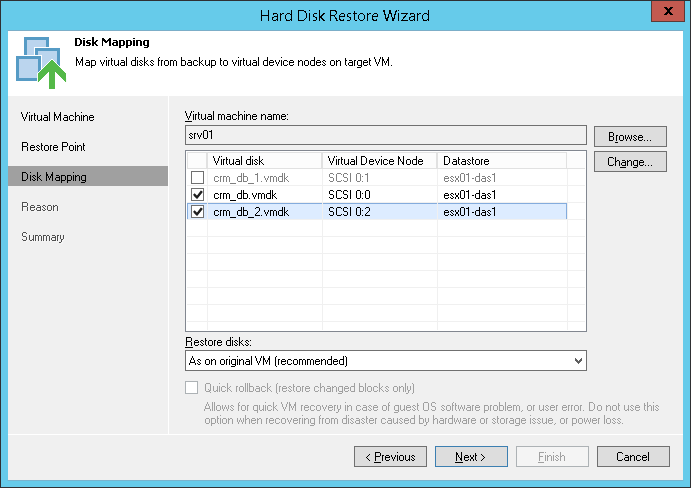At the Disk Mapping step, select virtual hard disks to restore, choose a VM to which the disks must be attached and define additional restore properties.
- By default, Veeam Backup Free Edition maps restored disks to the original VM. If the original VM was relocated or if you want to attach disks to another VM, you need to select the target VM manually. Click Browse and select the necessary VM from the virtual environment.
To facilitate selection, you can use the search field at the bottom of the window: click the button on the left of the field to select the necessary type of object that must be searched for, enter a VM name or a part of it and click the Start search button on the right or press [ENTER].
- Select check boxes next to virtual hard disks that you want to restore.
- To define virtual disk properties, select a disk in the list and click Change. In the Virtual Disk Properties section, pick a datastore where the restored hard disk must be located and select a virtual device node.
- If you want to replace an existing virtual disk, select an occupied virtual node.
- If you want to attach the restored disk to the VM as a new drive, select a node that is not yet occupied.
- Veeam Backup Free Edition preserves the format of the restored virtual hard disks. To change disk format, select the required option from the Restore disks list – same as on the original VM, force thin or force thick. Disk format change is supported only for VMs with Virtual Hardware version 7 or later.
- [For hard disk restore to the original location and with original format] Select the Quick rollback check box if you want to use incremental restore for the VM disk. Veeam Backup Free Edition will data blocks that are necessary to revert the VM disk to an earlier point in time, and will restore only these data blocks from the VeeamZIP file. Incremental restore significantly reduces the restore time and has little impact on the production environment.
It is recommended that you enable this option if you restore a VM disk after a problem that occurred at the level of the VM guest OS: for example, there has been an application error or a user has accidentally deleted a file on the VM guest OS. Do not enable this option if the problem has occurred at the VM hardware level, storage level or due to a power loss.








